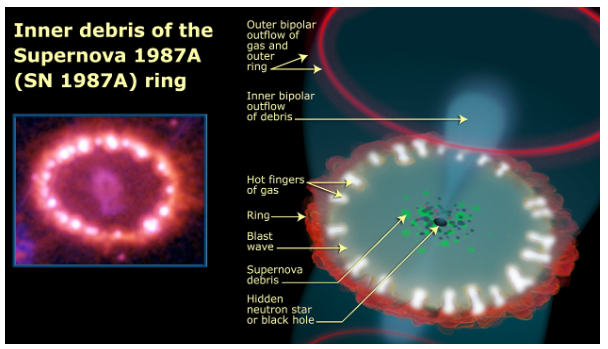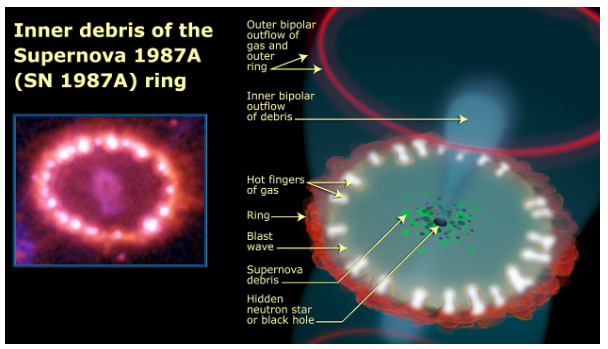- Courses
- GS Full Course 1 Year
- GS Full Course 2 Year
- GS Full Course 3 Year
- GS Full Course Till Selection
- CSAT
- 5 LAYERED ARJUNA Mentorship
- Public Administration Optional
- Online Program
- GS Recorded Course
- NCERT Batch
- Polity Module Course
- Geography Module Course
- Economy Module Course
- AMAC Module Course
- Modern India, Post Independence & World History Module Course
- Environment Module Course
- Governance Module Course
- Science & Tech. Module Course
- International Relations and Internal Security Module Course
- Disaster Management Module Course
- Ethics Module Course
- Essay Module Course
- Current Affairs Module Course
- ABOUT US
- OUR TOPPERS
- TEST SERIES
- FREE STUDY MATERIAL
- VIDEOS
- CONTACT US
String of Pearls Supernova
String of Pearls Supernova

Latest Context:
Exploring the Universe: The James Webb Space Telescope's New Revelation of SN1987A Supernova.
Introduction:
In recent news, the James Webb Space Telescope (JWST) has made headlines by capturing a captivating image of SN1987A, a supernova that exploded more than three decades ago. This celestial event offers us a unique opportunity to gain fresh insights into its history and evolution. But what exactly is SN1987A, and why is this discovery so important?
SN1987A Supernova: An Overview:
SN1987A, which burst onto the cosmic stage in the year 1987, is a supernova – a colossal explosion of a dying star. What makes this supernova particularly special is that it became the nearest and brightest one visible from Earth in almost four centuries. Situated at a staggering distance of 170,000 light-years away from our planet in the Large Magellanic Cloud, SN1987A has long fascinated astronomers.

The Significance of Magellanic Clouds:
Large Magellanic Cloud (LMC), is where SN1987A is located. The Magellanic Clouds are two irregular, satellite galaxies that orbit our Milky Way. While they are visible to the naked eye in the Southern Hemisphere, most people in the northern latitudes cannot observe them.
These clouds serve as excellent laboratories for studying the formation and evolution of stars due to their very active stellar processes.
The 'String of Pearls' Phenomenon:
SN1987A is often referred to as the "string of pearls." This captivating name stems from its appearance, which showcases a series of luminous rings composed of gases and dust. These rings were expelled by the dying star in various phases of its collapse and explosion.
What's fascinating is that these "pearls" of light comprise material that was ejected approximately 20,000 years before the actual supernova event. This revelation provides us with invaluable insights into the star's history and the intricate processes leading to its ultimate demise.
Unusual Facts about SN1987A:
- This supernova has some rather unusual characteristics that have piqued the curiosity of scientists. It defied conventional theories by exploding as a blue supergiant star, whereas it was generally believed that only red supergiant stars could undergo such an explosive transformation.
- Additionally, the emission of molecular hydrogen in the ring surrounding SN1987A was unexpected and could not have been observed without the advanced capabilities of the JWST.
The James Webb Space Telescope (JWST):
The JWST is often hailed as the successor to the Hubble Telescope and represents the pinnacle of NASA's space-based astronomical observatories. This cutting-edge telescope is a product of international collaboration between NASA, the European Space Agency (ESA), and the Canadian Space Agency (CSA).
Unlike the Hubble Telescope, the JWST primarily operates in the infrared part of the electromagnetic spectrum, allowing it to peer through cosmic dust clouds and observe celestial objects with incredible precision.
Conclusion:
The James Webb Space Telescope's recent image of SN1987A has brought this decades-old supernova back into the spotlight. It has allowed us to unlock the secrets of this cosmic event and challenge our existing understanding of the universe. As we continue to explore the cosmos with the JWST, we can look forward to more breathtaking discoveries that will expand our knowledge of the cosmos and our place within it.
What is the "String of Pearls" associated with SN1987A?
a. A famous jewellery collection found in the Milky Way
b. A series of luminous rings composed of gases and dust
c. A type of comet tail
d. A cluster of galaxies near the supernova
Correct Answer: b. A series of luminous rings composed of gases and dust
Must Check: Best IAS Coaching In Delhi



